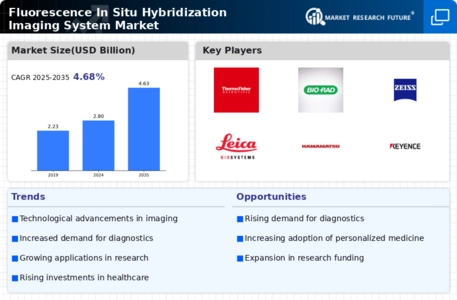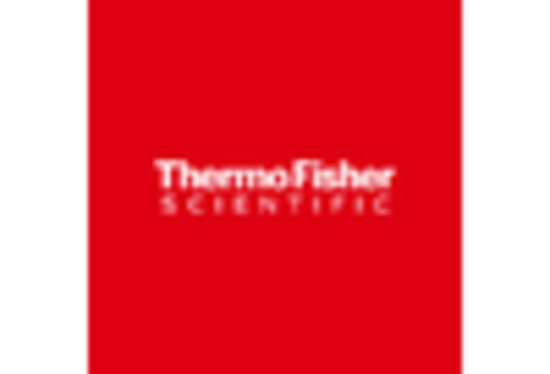Rising Demand in Oncology
The Fluorescence In Situ Hybridization Imaging System Market is witnessing a notable increase in demand driven by the rising incidence of cancer worldwide. As cancer remains a leading cause of mortality, the need for precise diagnostic tools is paramount. Fluorescence in situ hybridization (FISH) plays a critical role in identifying chromosomal abnormalities associated with various cancers, thereby aiding in early diagnosis and treatment planning. Market data indicates that the oncology segment accounts for a substantial share of the overall market, with projections indicating a continued rise in demand for FISH imaging systems. This trend is likely to be fueled by ongoing research and development efforts aimed at enhancing cancer diagnostics and personalized treatment approaches.
Personalized Medicine Trends
The Fluorescence In Situ Hybridization Imaging System Market is increasingly influenced by the trends in personalized medicine. As healthcare shifts towards tailored treatment strategies, the demand for precise diagnostic tools that can identify specific genetic markers is growing. FISH technology is particularly valuable in this context, as it allows for the detection of genetic alterations that inform treatment decisions. The market is expected to expand as healthcare providers seek to implement personalized medicine approaches, which require advanced imaging systems for accurate genetic profiling. Current estimates suggest that the personalized medicine segment could account for a significant portion of the market, reflecting the broader shift towards individualized patient care.
Growing Research and Development Activities
The Fluorescence In Situ Hybridization Imaging System Market is benefiting from increased research and development activities across various sectors, including academia and biotechnology. As researchers seek to explore genetic and cellular mechanisms, the demand for advanced imaging systems is on the rise. FISH technology is particularly favored for its ability to provide detailed insights into chromosomal structures and functions. Funding from governmental and private organizations for genomic research is also contributing to market growth. Current data indicates that investment in R&D is expected to rise, potentially leading to innovative applications of FISH imaging systems in both clinical and research environments.
Technological Advancements in Imaging Systems
The Fluorescence In Situ Hybridization Imaging System Market is experiencing a surge in technological advancements that enhance imaging capabilities. Innovations such as high-resolution imaging and automated analysis tools are becoming increasingly prevalent. These advancements facilitate more accurate and efficient detection of genetic abnormalities, which is crucial in various applications, including cancer diagnostics. The integration of artificial intelligence and machine learning algorithms into imaging systems is also noteworthy, as it allows for improved data interpretation and analysis. As a result, the market is projected to grow significantly, with estimates suggesting a compound annual growth rate of over 10% in the coming years. This growth is indicative of the increasing reliance on advanced imaging technologies in clinical and research settings.
Increasing Awareness and Adoption in Clinical Settings
The Fluorescence In Situ Hybridization Imaging System Market is experiencing increased awareness and adoption of FISH technology in clinical settings. Healthcare professionals are becoming more informed about the benefits of using FISH for accurate genetic analysis, particularly in oncology and genetic disorders. This growing awareness is leading to a higher adoption rate of FISH imaging systems in hospitals and diagnostic laboratories. Market data suggests that as more healthcare providers recognize the value of precise genetic diagnostics, the demand for FISH technology will continue to rise. This trend is likely to be supported by educational initiatives and training programs aimed at enhancing the skills of healthcare professionals in utilizing advanced imaging systems.

















Leave a Comment